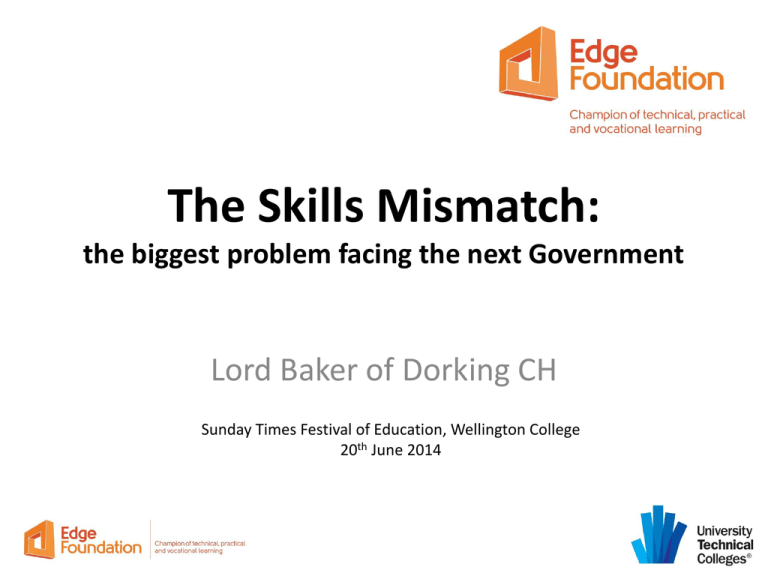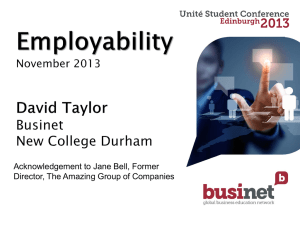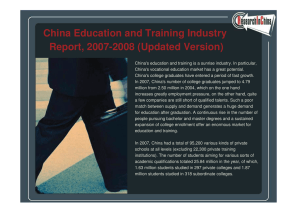the biggest problem facing the next Government (presentation by
advertisement

The Skills Mismatch: the biggest problem facing the next Government Lord Baker of Dorking CH Sunday Times Festival of Education, Wellington College 20th June 2014 We know the problem: In 2013, the top two shortages for jobs worldwide were for skilled trades workers and engineers. Global Talent Shortage Survey, Manpower Group The economy is changing 250 Net growth in job numbers, 2010-20 (thousands) 200 150 100 50 0 -50 -100 -150 -200 Science, Science, Skilled engineering and engineering and agriculture L3 technology technology professionals technicians (Level 4) Skilled metal, electrical, electronics L3 Skilled construction L3 1000 An even bigger story: the baby boomers are retiring 800 600 400 200 0 -200 Replacement demand (Thousands) Huge numbers of people will be needed by 2020 • Between 2012 and 2020, we need – – 830,000 SET professionals (degree level) – 450,000 SET technicians (levels 3 and 4) • SET = science, engineering and technology • Figures include growth + replacement demand (mainly to replace baby boomers planning to retire) UNIVERSITIES But supply won’t meet demand • Demand for science, engineering and technology graduates: 104,000 per year between 2012 and 2020 • Number of new graduates taking UK jobs in SET occupations: 64,000 per year • Shortfall: 40,000 graduates per year Higher education has grown rapidly – but not in all subjects % Increase in first degrees 2002-12 Humanities Business/admin Creative arts/design Physical sciences Engineering/technology Computer science 0 20 40 60 80 100 Percentage of graduates in non-graduate jobs 30 months after graduating, by class of degree Purcell K, Elias P, Atfield G, Behle H, Ellison R and Luchinskaya D (2013), Futuretrack: Transitions into Employment, Further Study and Other Outcomes. Manchester: Higher Education Careers Services Unit Employment in retail, catering, waiting and bar jobs six months after completing a first degree in 2012 Area of study Fine Arts Media Studies Performing Arts Design Sociology Physical and Geographical Sciences History English Biology Law Psychology Geography Percentage of graduates in work who had retail, catering, waiting and bar jobs 29.0 26.7 23.5 23.1 22.7 22.1 21.1 21.4 20.8 19.8 18.9 18.8 Sports Science Marketing Politics Languages All employed graduates Business and Management Studies Chemistry Finance and Accountancy Computer Science and IT Maths Physics Electrical and Electronic Engineering Economics Architecture and Building Mechanical Engineering Civil Engineering 17.4 15.9 15.4 15.2 13.7 13.7 13.1 11.3 10.5 9.3 9.0 8.8 7.9 7.9 5.6 4.7 AGCAS and HECSU (2013), What Do Graduates Do? http://www.hecsu.ac.uk/assets/assets/documents/WDGD_Sept_2013.pdf SCHOOLS Over the last 20 years, there has been a steady erosion of laboratory skills taught in school science. Gatsby Charitable Foundation The development of D & T in the UK has seen a move away from a skillsfocused curriculum to a knowledgefocused one. Mike Martin and Gwyneth Owen-Jackson: Is design and technology about making or knowing? Design and Technology GCSE: only one student in three takes a high-tech option 16% 26% Resistant materials 2% 4% Food technology Graphic products Textiles technology Electronic products 13% Systems and control 21% 18% Other GCSE Design and Technology Entries, 2013 But Design and Technology GCSE is taken by only one student in three 2013 entries 700,000 600,000 500,000 400,000 300,000 200,000 100,000 0 Took any GCSE Took D&T Therefore the proportion of all students taking high-tech options is… • Resistant Materials: • Electronic Products: • Systems and Control: 8.4% 1.4% 0.6% FURTHER EDUCATION • In Austria, technical and vocational education starts at 14. • In England, most technical and vocational education starts at 16 – two years behind. Other countries value vocational education more highly … % young people on vocational courses 90 80 70 60 50 40 30 20 10 0 Hungary UK Denmark Germany Netherlands Austria …and have lower youth unemployment % of under 25s who are unemployed 30 25 20 15 10 5 0 Hungary UK Denmark Germany Netherlands Austria The connection is obvious 100 80 60 40 20 0 % young people on vocational courses % youth unemployment Number of 16-24s starting apprenticeships in 2011/12 % change since 2010/11 Business, admin and the law 80,320 14.5% Retail and commercial enterprise 63,670 7.6% Health, public services and care 49,910 10.5% Engineering and manufacturing 38,100 6.8% Percentage of each age group participating in apprenticeships at the end of 2012 We need new specialist institutions “Smaller specialist units, including University Technical Colleges, should be created with stronger links to business, commerce and industry.” Sir Michael Wilshaw, Her Majesty’s Chief Inspector Unseen Children, speech, 20 June 2013 New pathways: University Technical Colleges The 50 approved UTCs Some employers partnering with UTCs Universities partnering with UTCs New pathways: Career Colleges Career Colleges • Established by further education colleges subjects linked to labour market – hospitality, catering, tourism, financial science, digital graphic art. • Employers: • partners in designing and delivering the curriculum • 40% of career college board members • Progression to apprenticeships, higher education and employment • Two pioneering Career Colleges opening in September 2014 in Bootle and Oldham. New institutions will make a huge difference – but they are not enough on their own. Every school should have a link with engineering and manufacturing. My recommendations • Get in touch with your local school. Don’t take “no” for an answer. • Rally behind a smaller number of big initiatives in schools. • Support teachers, especially in Design and Technology. • Get a 3D printer into every school. A FINAL THOUGHT A target for all schools: So support UTCs!











